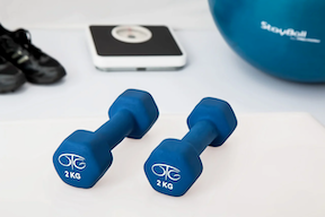Exercise and ALS |
|
|
An ALS diagnosis will change the way you’ll need to approach exercise. On this page, two physical therapists from the Duke ALS Clinic answer common questions about exercise and ALS. Laura Good Kennedy and Amanda Beaty have Doctor of Physical Therapy degrees, develop exercise programs for people living with ALS, and educate on strategies to help maintain mobility.
|
|
Before starting or modifying your exercise program, always discuss your individual situation with your physical therapist.
Can I exercise after my diagnosis?
|
In general, the answer to this question is yes. Research about specific exercise for people with ALS is limited, but studies have shown that moderate intensity exercise is not harmful and can be beneficial for a person’s quality of life.
Some studies suggest that it can slow decline in function. Exercise is also important to avoid disuse atrophy, or weakness, that results from not using muscles. |
|
|
However, some studies have shown that high intensity or repetitive physical activity could result in decreased strength due to overfatigue of motor neurons. Motor neurons are the nerve cells that degenerate during the disease process of ALS. As a result, your exercise program should be matched to your level of physical ability.
Since ALS affects each person differently, there are no “one size fits all” exercise programs. It is important to discuss your specific program with your physical therapist, who will take a variety of factors into consideration when making recommendations about exercise, including your prior activity level, current strength and mobility, rate of progression of symptoms, balance, respiratory function, and exercise goals. This helps develop a safe program that meets your individual needs. Your exercise program will need to be modified as these factors change over time.
|
|
How do I know if I'm working too hard?
A simple way to think about exercise is to do it, just don’t overdo it. It becomes easier to overuse your muscles as ALS progresses, so it is important to monitor symptoms of overwork with any exercise or activity. These include an inability to perform daily activities because of fatigue, decreased strength, or increased soreness or cramping. Breaking up exercise into shorter sessions with rest breaks in between can be helpful in managing symptoms. Discuss any symptoms you notice with your physical therapist.
What type of exercise should I do?
The best type of exercise is one you enjoy. If you had a regular exercise routine prior to your diagnosis, you can usually continue it with modifications. Discuss your exercise program regularly with your physical therapist.
- Stretching/flexibility exercises can help prevent the tightening of your muscles, tendons, and ligaments and reduce pain. Stretching programs should be initiated early on in the disease and maintained throughout, particularly shoulder stretches. Stretching routines may consist of exercises you can complete independently, or they may require assistance from a caregiver.
- Aerobic conditioning is also important in helping to slow respiratory decline. Walking, swimming, and stationary bicycling are all options for aerobic exercise. Usually treadmills, uneven surfaces, and outdoor bicycling should be avoided because of the increased risk of falling. Exercise in group settings or classes can be motivating and provide an opportunity to socialize.
- Strengthening exercises can be completed with a goal of preserving muscle strength and tone. If you go to the gym regularly, you might need to make some adjustments to your weight lifting routine. As discussed above, moderate intensity exercise is the target for people living with ALS. This means that high resistance or maximal strengthening exercises should be avoided. To achieve moderate-intensity, choose a weight you could use to perform 20 repetitions, but only do 10. This ensures that you are not overworking your muscles. Exercises geared toward weight lifting should be performed using muscles that still have good strength. If you cannot move your arm or leg through the full range of motion without a weight, do not add weight or resistance to it. Aquatic exercise can also be beneficial as it allows you to move against gentle resistance in an unweighted environment.
Should I feel tired after I exercise?
Feelings of fatigue or weakness should not last more than 20-30 minutes after exercise or activity. If they persist, this indicates you have overworked. Fatigue often signals that your respiratory function and/or muscle strength are unable to keep up with your exercise or activity. Prolonged fatigue or muscle weakness increases your risk of falling.
Should I be sore after I exercise?
You should not experience pain during or after exercise. The feeling of “muscle burn” indicates that you have overexerted yourself and should be avoided.
Will physical therapy or exercise help strengthen my muscles?
Unfortunately, there is no significant evidence to support the idea of increasing muscle strength through exercise in ALS. One of the goals of exercise is to preserve muscle strength and tone and to prevent deconditioning as a result of disuse. The physical therapist at your ALS clinic should assess your strength and function at each clinic visit and may recommend follow up with local outpatient or home health therapy based on your needs.
Outpatient physical therapists can assist with establishing or modifying your exercise program, stretching or joint mobilizations for painful shoulders, or training on how to walk with new braces or devices. As it becomes more difficult to move around your home, a home health physical therapist can educate you on ways to make transfers easier and safer, and also train your family members or caregivers on the best ways to help you with stretching, mobility, or daily tasks.
Outpatient physical therapists can assist with establishing or modifying your exercise program, stretching or joint mobilizations for painful shoulders, or training on how to walk with new braces or devices. As it becomes more difficult to move around your home, a home health physical therapist can educate you on ways to make transfers easier and safer, and also train your family members or caregivers on the best ways to help you with stretching, mobility, or daily tasks.




